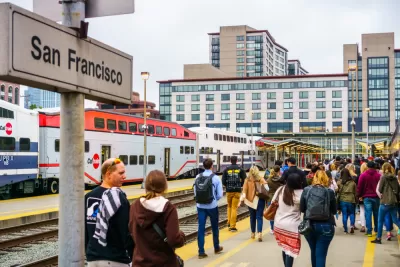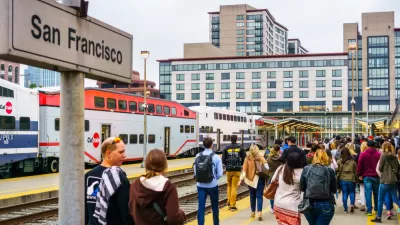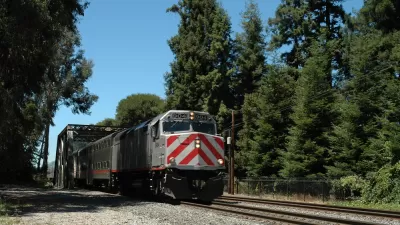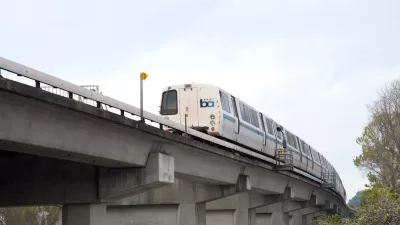A plan to integrate the various regional transit providers in the San Francisco Bay Area could be the key to winning back transit riders in the post-pandemic world.

Momentum is building for an idea that would merge Bay Area Rapid Transit (BART) with CalTrain and other regional rail providers to create a single regional rail system that would completely encircle the San Francisco Bay Area, reports Nico Savidge.
Seamless Bay Area released a report earlier this month that "recommends bringing BART, Caltrain and other longer-distance operators such as San Francisco Bay Ferry and the North Bay's Golden Gate Transit together into a single system that stretches from Santa Rosa to Gilroy," according to Savidge.
The report recommends an integrated fare system that would create a zone system for fares—charging one price even if riders transfer from one system to another within a zone.
"It's a long-debated idea, but there are signs momentum could be building," writes Savidge. "A merger with BART is one of the concepts Caltrain's board is considering this year as it overhauls the railroad's management. And COVID-19 has upped the pressure throughout the Bay Area to better coordinate service between agencies if they want to win back riders in the post-pandemic world."
Savidge provides more evidence of the growing political momentum for the idea in the source article (which is also available at Mass Transit if The Mercury News paywall is an obstacle). One key driver of the new momentum for the idea of integrated regional rail in the Bay Area is the need to entice riders back to transit in the post-pandemic world.
Meanwhile, Seamless Bay Area has launched a Kickstarter to raise the funds to create a board game called Connect the Bay to illustrate the integrated fare concept.
FULL STORY: Could a BART-Caltrain merger help fix one of Bay Area transit's biggest problems?

Maui's Vacation Rental Debate Turns Ugly
Verbal attacks, misinformation campaigns and fistfights plague a high-stakes debate to convert thousands of vacation rentals into long-term housing.

Planetizen Federal Action Tracker
A weekly monitor of how Trump’s orders and actions are impacting planners and planning in America.

San Francisco Suspends Traffic Calming Amidst Record Deaths
Citing “a challenging fiscal landscape,” the city will cease the program on the heels of 42 traffic deaths, including 24 pedestrians.

Adaptive Reuse Will Create Housing in a Suburban Texas Strip Mall
A developer is reimagining a strip mall property as a mixed-use complex with housing and retail.

Study: Anti-Homelessness Laws Don’t Work
Research shows that punitive measures that criminalized unhoused people don’t help reduce homelessness.

In U.S., Urban Gondolas Face Uphill Battle
Cities in Latin America and Europe have embraced aerial transitways — AKA gondolas — as sustainable, convenient urban transport, especially in tricky geographies. American cities have yet to catch up.
Urban Design for Planners 1: Software Tools
This six-course series explores essential urban design concepts using open source software and equips planners with the tools they need to participate fully in the urban design process.
Planning for Universal Design
Learn the tools for implementing Universal Design in planning regulations.
Heyer Gruel & Associates PA
JM Goldson LLC
Custer County Colorado
City of Camden Redevelopment Agency
City of Astoria
Transportation Research & Education Center (TREC) at Portland State University
Jefferson Parish Government
Camden Redevelopment Agency
City of Claremont





























